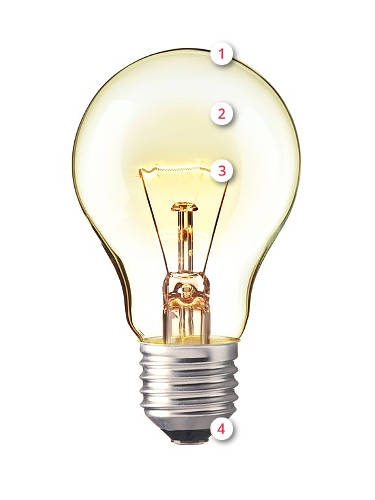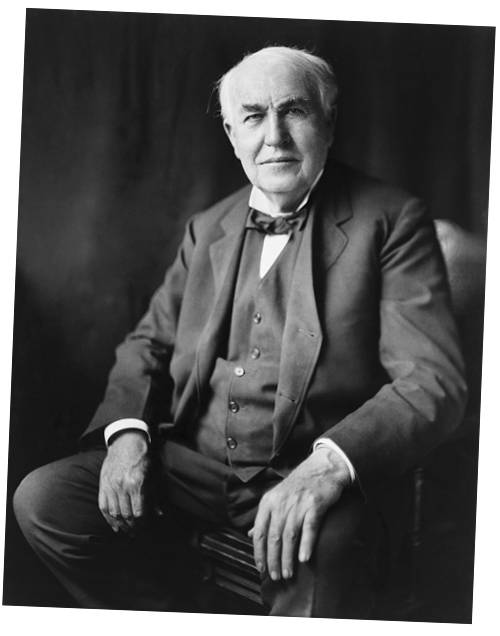Incandescent lamps, as the epitome of cozy light or even as a design object, have not lost any of its popularity. The light bulb ban in many states has meanwhile largely removed the “light bulb” from the market.
But the alternatives – the energy-saving lamp and above all the energy-efficient LED lamp – had to adapt to the incandescent lamp. And, not only in terms of light quality but also in visual appearance.
This becomes particularly clear with the LED filament lamp, further development of LED technology into a light source similar to incandescent lamps.
But what exactly does “bulb-like” mean? How is a light bulb constructed? What qualities of light have made it so successful? And why was the light bulb banned?
We will look back at the Incandescent lamps, which have provided light for more than 120 years.
Incandescent Lamps Construction
The construction of an incandescent lamp is similar to energy-saving lamps or LED lamps.
This explains the low production costs and the once widespread use of the lamp in almost every lighting application.

1. Outer cover
It is made of glass and prevents the filament from burning due to the oxygen content in the ambient air. It can either be transparent, matt or partially mirrored.
2. Inside the bulb
The glass bulb is either empty or filled with gas. The gas reduces the sublimation rate, i.e. the amount of metal that evaporates from the filament during operation.
3. Filament
It consists of a current-conducting material, in most cases of tungsten. If current flows through the filament, it heats up until it glows. The temperature is several thousand degrees Celsius.
4. Base
The base fixes the lamp in the socket and enables electrical contact. The usual incandescent lamps have an Edison base (E27), i.e. a standardized screw thread with a diameter of 2.7 cm.
How do incandescent lamps work?
The most important part of an incandescent lamp is its electrically conductive filament. If current flows through the thread, it heats up to several thousand degrees Celsius.
The energy is converted into radiation. The main part of an incandescent lamp, however, consists of infrared radiation – heat radiation. For this reason, the incandescent lamps, as well as the halogen lamp, are called temperature radiators.
With an incandescent lamp, only 2.5-5% of the energy is converted into visible light. The remaining 95-97.5% creates heat.
History of the light bulb
The screw thread of an incandescent lamp is called an Edison socket and there are many other signs that Thomas Alva Edison is the inventor of the incandescent lamp.
But studies have shown that the light bulb was already there before him.
However, as with many inventions, the incandescent lamp lacked a good marketing idea. And that’s where Edison came in.
The inventor and entrepreneur, born in the United States in 1847, distinguished himself, among other things, by the invention of the phonograph, to which he owed his breakthrough.
The phonograph records voices and plays them back.

Another important step in the history of the incandescent lamp is the change from carbon thread to tungsten wire. Since 1910, incandescent lamps have been shining with a filament made of heat-resistant tungsten.
What distinguishes the light from an incandescent lamp?
The light of the incandescent lamp was and still is the epitome of a homely lighting atmosphere. The light from incandescent lamps is such because of several properties:
Light color: Incandescent lamps have a color temperature of less than 2,900 Kelvin. This makes the light reddish and very homely.
Color rendering: Incandescent lamps reach up to Ra 100. This means that colors are reproduced true to nature as in real daylight.
Dimming feature: Incandescent lamps are dimmable and the light becomes optically warmer the more you dim the illuminant.
Immediately 100% brightness: when switched on, light bulbs immediately reach their maximum luminous flux.
Appearance: The light bulb with its luminous thread looks beautiful and fits perfectly into a homely interior style.
FAQs: You have to know about incandescent lamps
Why does incandescent lamp burn?
This is because atoms gradually evaporate from the glowing tungsten wire. Evaporated material settles on the flask as a gray film. The thread becomes thinner and eventually burns out.
How long do incandescent lamps last?
Incandescent lamps burn out after a maximum of 1,000 hours. In the case of halogen lamps, the halogen gases in the bulb fill partially return the material to the filament, which increases the service life.
How to dispose of incandescent lamps?
In contrast to, for example, energy-saving lamps, incandescent lamps do not contain any environmentally harmful ingredients. Therefore, incandescent lamps can be disposed of with normal household waste.
Which light bulbs are dimmable?
In contrast to LED lamps, for example, incandescent lamps can generally be dimmed with a dimmer. In the case of incandescent lamps, the color temperature also drops when dimming and the light becomes redder. This effect is increasingly becoming popular in many modern LED lamps.
Why you should not touch incandescent lamps?
Incandescent lamps get hot when in use. Therefore, no flammable materials should come into the vicinity and you should avoid touching them. If you need to replace the bulb, first completely disconnect it from the power supply and let it cool down before changing.
Why should incandescent lamps no longer be sold?
For reasons of environmental protection, the European Union already passed a regulation in 2009, which places demands on the energy efficiency of a lamp.
In several continuous steps, all household lamps that do not have at least energy efficiency class B were banned. This prohibition includes not only incandescent lamps but also halogen lamps. These lamps use too much energy and produce too little light. A light bulb emits 95-97.5% of heat instead of light.
Some bulbs are not affected by EU regulation.
- Special lamps for household appliances such as ovens, refrigerators or microwaves
- Special lamps for plants, aquariums or terrariums
- Heat generation lamps (infrared lamps)
- Signal lamps (e.g. for traffic lights)
- Decorative lamps with a luminous flux of fewer than 60 lumens
Alternative to incandescent lamps
There are various lighting technologies as alternatives to incandescent lamps. Energy-saving lamps are compact fluorescent lamps with a coated tube. The filling gas inside generates UV light when discharged, which is converted into visible light by the coating.
LED lamps are electronic semiconductor components that convert electrical energy into light. What these lighting technologies have in common is that they can produce more brightness with less energy: energy efficiency is higher. Illuminants with these lighting technologies have energy efficiency classes up to A ++.
With the change to new lighting technologies, however, there are new criteria to consider when evaluating a lamp. The most important is the light color and the use of lumens instead of watts to assess the brightness.
Comparison of different technologies
How to retrofit LED?
The fact that incandescent lamps should no longer be used in a lamp does not mean that you need to replace the lamps (hanging lamps, ceiling lamps, table lamps, and others).
Each light bulb has a base for the socket of the lamp. To switch to another lamp, you only have to choose an alternative with a suitable base. That means: the lighting technology differs, but the base remains the same.
Retrofits are modern lamps that combine new lighting technology with a conventional socket. And these retrofits are also available as energy-saving lamps and LEDs.
Which light bulb alternative is suitable for open lamps?
The optimal light bulb alternative for open luminaries are LED filament lamps
Nobody wants to see an energy saving spiral in an open pendant lamp.
For this reason, the manufacturers produce a clear lamp with a filament that looks similar to that of the light bulb: the LED filament lamp.
It looks like an incandescent lamp but has all the advantages of the LED.









